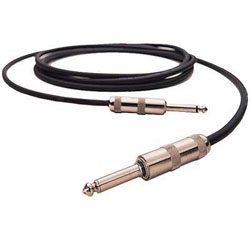
What does the shield do?
The copper shield of a coaxial cable acts as the return conductor for the signal current and as a barrier to prevent interference from reaching the “hot” center conductor.
Unwanted types of interference encountered and blocked with varying degrees of success by cable shielding include radio frequency (RFI) (CB and AM radio), electromagnetic (EMI) (power transformers) and electrostatic (ESI) (SCR dimmers, relays, fluorescent lights).
What makes one shield better than another?
To be most effective the cable shield is tied to a ground—usually a metal amplifier or mixer chassis that is in turn grounded to the AC power line. Cable shielding effectiveness against high-frequency interference fields is accomplished by minimizing the transfer impedance of the shield.
At frequencies below 100 kHz, the transfer impedance is equal to the DC resistance—hence, more copper equals better shielding.
Above 100 kHz the skin effect previously referred to comes into play and increases the transfer impedance, reducing the shielding effectiveness.
Another important parameter to consider is the optical coverage of the shield, which is simply a percentage expressing how complete the coverage of the center conductor by the shield is.
What are the characteristics of the three basic types of cable shields? Which is best?
A braided shield is applied by braiding bunches of copper strands called picks around the insulated, electrostatically shielded center conductor. The braided shield offers a number of advantages.
Its coverage can be varied from less than 50% to nearly 97% by changing the angle, the number of picks and the rate at which they are applied. It is very consistent in its coverage, and remains so as the cable is flexed and bent.
This can be crucial in shielding the signal from interference caused by radio-frequency sources, which have very short wavelengths that can enter very small “holes” in the shield. This RF-shielding superiority is further enhanced by very low inductance, causing the braid to present a very low transfer impedance to high frequencies.
This is very important when the shield is supposed to be conducting interference harmlessly to ground.
Drawbacks of the braid shield include restricted flexibility, high manufacturing costs because of the relatively slow speed at which the shield-braiding machinery works, and the laborious “picking and pigtailing” operations required during termination.
A serve shield, also known as a spiral-wrapped shield, is applied by wrapping a flat layer of copper strands around the center in a single direction (either clockwise or counter-clockwise). The serve shield is very flexible, providing very little restriction to the “bendability” of the cable.
Although its tensile strength is much less than that of braid, the serve’s superior flexibility often makes it more reliable in “real-world” instrument applications.
Tightly braided shields can be literally shredded by being kinked and pulled, as often happens in performance situations, while a spiral-wrapped serve shield will simply stretch without breaking down.
Of course, such treatment opens up gaps in the shield which can allow interference to enter. The inductance of the serve shield is also a liability when RFI is a problem; because it literally is a coil of wire, it has a transfer impendance that rises with frequency and is not as effective in shunting interference to ground as a braid. The serve shield is most effective at frequencies below 100 kHz.
From a cost viewpoint, the serve requires less copper, is much faster and hence cheaper to manufacture, and is quicker and easier to terminate than a braided shield.
It also allows a smaller overall cable diameter, as it is only composed of a single layer of very small (typically 36 AWG) strands. these characteristics make copper serve a very common choice for audio cables.
The foil shield is composed of a thin layer of mylar-backed aluminum foil in contact with a copper drain wire used to terminate it.
The foil shield/drain wire combination is very cheap, but it severely limits flexibility and indeed breaks down under repeated flexing. The advantage of the 100% coverage offered by foil is largely compromised by its high transfer impedance (aluminum being a poorer conductor of electricity than copper), especially at low frequencies.
